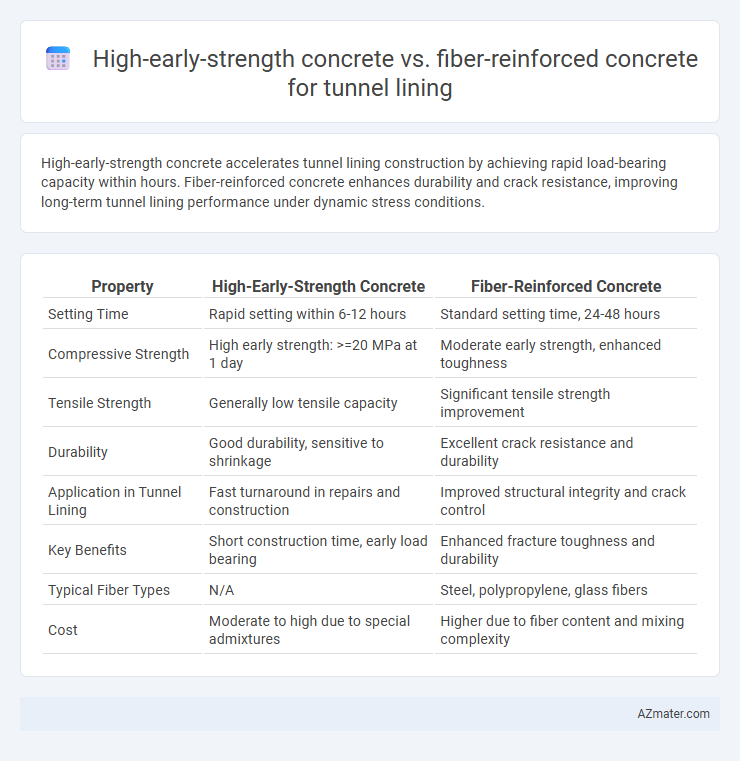High-early-strength concrete accelerates tunnel lining construction by achieving rapid load-bearing capacity within hours. Fiber-reinforced concrete enhances durability and crack resistance, improving long-term tunnel lining performance under dynamic stress conditions.
Table of Comparison
| Property | High-Early-Strength Concrete | Fiber-Reinforced Concrete |
|---|---|---|
| Setting Time | Rapid setting within 6-12 hours | Standard setting time, 24-48 hours |
| Compressive Strength | High early strength: >=20 MPa at 1 day | Moderate early strength, enhanced toughness |
| Tensile Strength | Generally low tensile capacity | Significant tensile strength improvement |
| Durability | Good durability, sensitive to shrinkage | Excellent crack resistance and durability |
| Application in Tunnel Lining | Fast turnaround in repairs and construction | Improved structural integrity and crack control |
| Key Benefits | Short construction time, early load bearing | Enhanced fracture toughness and durability |
| Typical Fiber Types | N/A | Steel, polypropylene, glass fibers |
| Cost | Moderate to high due to special admixtures | Higher due to fiber content and mixing complexity |
Introduction to Tunnel Lining Materials
High-early-strength concrete accelerates the curing process, enabling faster tunnel lining installation and early load-bearing capacity, reducing project timelines. Fiber-reinforced concrete enhances tensile strength and crack resistance, improving durability and structural integrity under dynamic loads commonly encountered in tunnel environments. Selecting the appropriate material depends on balancing rapid strength gain with long-term performance requirements in tunnel construction.
Overview of High-Early-Strength Concrete
High-early-strength concrete is designed to achieve rapid strength gain, typically reaching 70% of its 28-day strength within 24 hours, making it ideal for tunnel lining applications where fast construction cycles and early load resistance are critical. This concrete type contains high cement content and accelerators that enhance hydration rates, enabling early formwork removal and reducing construction time. Its high early strength improves structural stability in tunnel linings, supports rapid excavation progress, and minimizes exposure time to adverse environmental conditions during construction.
What is Fiber-Reinforced Concrete?
Fiber-reinforced concrete (FRC) is a composite material that incorporates discrete fibers such as steel, glass, or synthetic polymers within the cementitious matrix to enhance its tensile strength, durability, and crack resistance, making it ideal for tunnel lining applications where structural integrity is critical. Unlike high-early-strength concrete, which gains strength rapidly to reduce construction time, FRC improves long-term performance by controlling shrinkage cracks and improving impact and fatigue resistance under dynamic tunnel loads. The use of fibers in concrete also enhances toughness and ductility, contributing to increased safety and longevity in tunnel linings exposed to environmental stressors and mechanical wear.
Key Properties Comparison: Strength and Durability
High-early-strength concrete achieves rapid compressive strength gain, often reaching 20-30 MPa within 24 hours, which accelerates tunnel lining construction schedules. Fiber-reinforced concrete, incorporating synthetic or steel fibers, significantly enhances toughness, crack resistance, and long-term durability under cyclic loading and underground environmental conditions. While high-early-strength concrete offers superior early load-bearing capacity, fiber-reinforced concrete provides improved post-cracking behavior and resistance to fatigue, essential for the structural integrity and service life of tunnel linings.
Construction Speed and Early Set Advantages
High-early-strength concrete accelerates tunnel lining construction by reaching significant compressive strength within hours, allowing for rapid formwork removal and minimizing project duration. Fiber-reinforced concrete enhances durability and crack resistance during early curing but typically gains strength more gradually, which may slightly slow construction speed compared to high-early-strength mixes. The early set advantage of high-early-strength concrete is critical for time-sensitive tunnel projects, whereas fiber-reinforced concrete offers long-term structural integrity benefits without compromising initial construction pace significantly.
Crack Control and Structural Integrity
High-early-strength concrete accelerates setting time and load-bearing capacity, enhancing structural integrity in tunnel linings by allowing rapid construction and early stress resistance. Fiber-reinforced concrete significantly improves crack control through the distribution of microfibers that inhibit crack propagation, thereby increasing durability and reducing maintenance needs. Combining both materials can optimize tunnel lining performance by balancing fast strength development with superior crack resistance and long-term stability.
Durability in Aggressive Tunnel Environments
High-early-strength concrete exhibits rapid strength gain critical for early load-bearing in tunnel lining but may suffer from microcracking under aggressive chemical exposure, reducing long-term durability. Fiber-reinforced concrete enhances crack resistance and toughness, improving durability against mechanical stresses and chemical attacks in aggressive tunnel environments. Combining high-early-strength properties with optimized fiber reinforcement offers a balanced solution to maintain tunnel lining integrity and extend service life.
Cost Implications and Life Cycle Analysis
High-early-strength concrete offers rapid strength gain, reducing formwork and construction time costs in tunnel lining projects, but its higher material expenses may impact initial investment. Fiber-reinforced concrete, while typically more costly upfront due to fiber additives, enhances durability and crack resistance, lowering maintenance and repair expenses over the tunnel's service life. Life cycle analysis reveals that fiber-reinforced concrete can provide better long-term cost efficiency by extending durability and reducing operating costs compared to conventional high-early-strength mixtures.
Application Case Studies in Tunnel Projects
High-early-strength concrete is frequently utilized in tunnel lining projects requiring rapid load-bearing capacity to minimize downtime, as seen in the Gotthard Base Tunnel where accelerated construction schedules demanded early strength gain. Fiber-reinforced concrete demonstrates superior crack resistance and durability under cyclic loading, exemplified in the Channel Tunnel where steel fibers enhanced structural integrity and reduced maintenance. Comparative case studies highlight that while high-early-strength concrete optimizes construction speed, fiber-reinforced concrete improves long-term performance and safety in tunnel linings.
Choosing the Optimal Concrete Type for Tunnel Lining
High-early-strength concrete accelerates construction schedules due to its rapid strength gain, making it ideal for tunnel lining projects requiring quick formwork removal and early load application. Fiber-reinforced concrete enhances durability and crack resistance, improving tunnel lining performance under dynamic loads and seismic conditions. Selecting the optimal concrete type depends on balancing early strength needs with long-term durability, project timeline, and environmental exposure factors specific to the tunnel infrastructure.

Infographic: High-early-strength concrete vs Fiber-reinforced concrete for Tunnel lining
 azmater.com
azmater.com